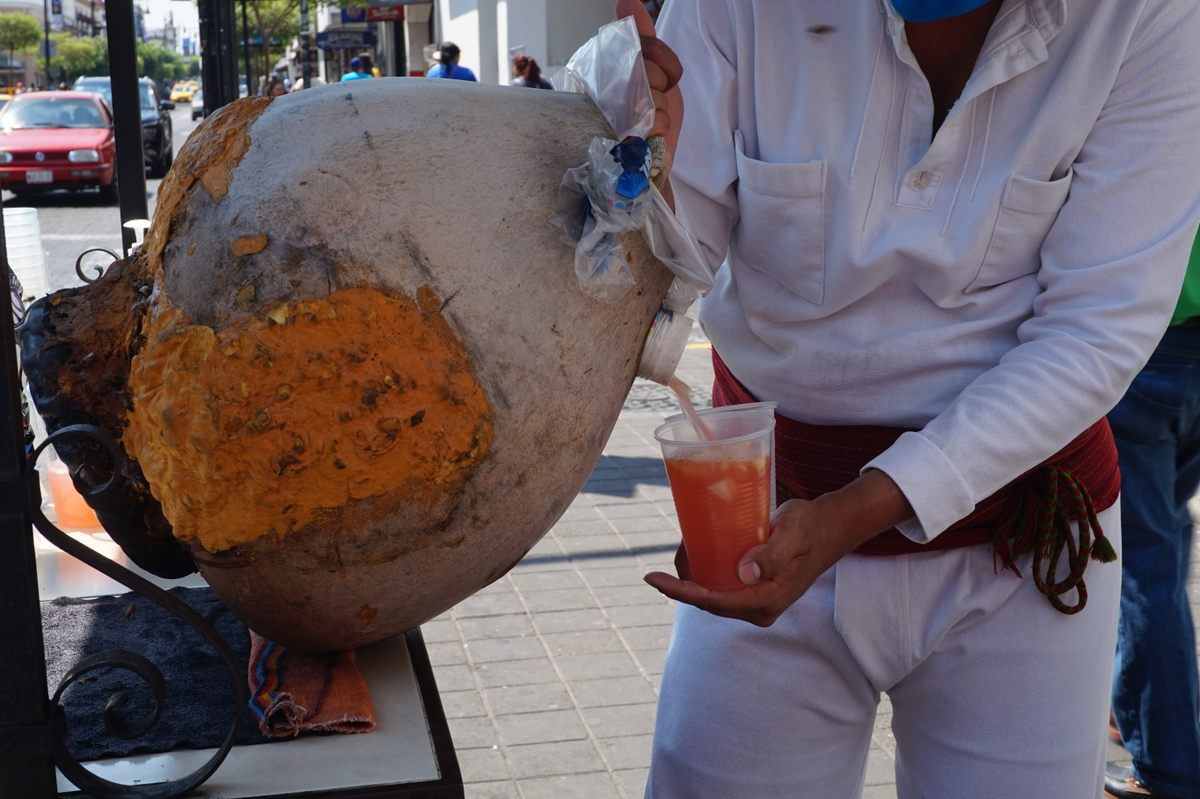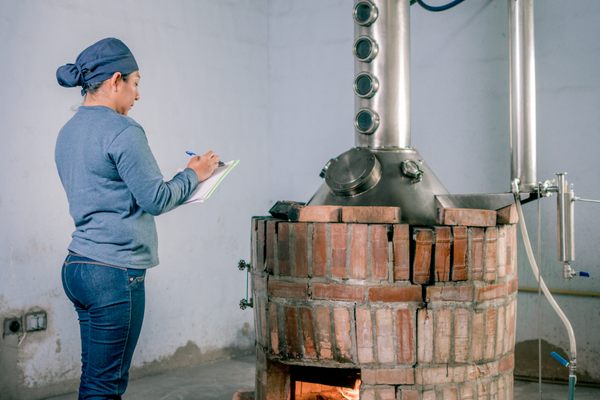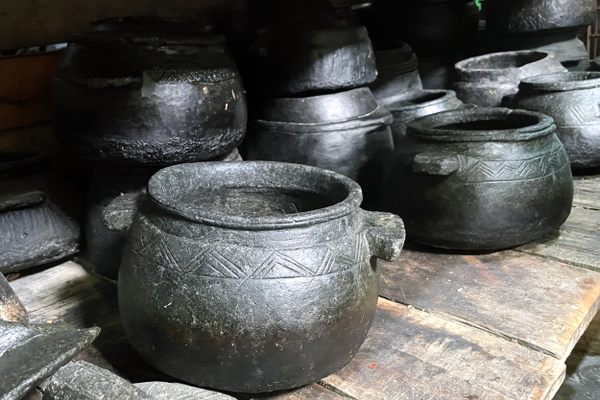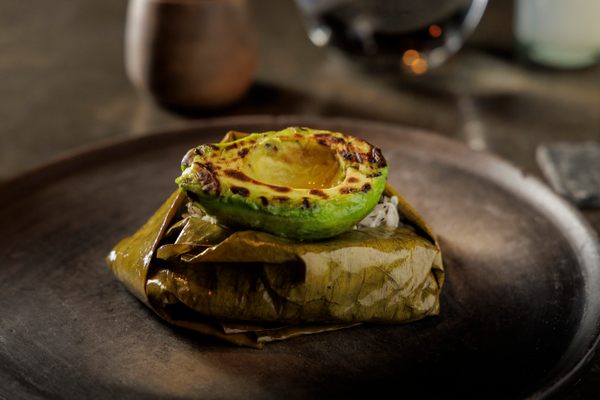Is This Mexico’s Oldest Spirit?
In the state of Colima, one man is reviving vino de cocos, a distillate that disappeared in the 1700s.
As the city of Colima, Mexico, wakes up, barefoot men tie soda bottles behind their backs and scramble up 66-foot-tall palm trees without a safety net. They place the balls of their feet in slits chopped at intervals into the trunks of the palms. When they get to the canopy, they slice a sliver off each palm flower and dump some liquid into their bottles that had dripped out the night before.
These are Colima’s tuberos and their job is to extract tuba, the sap of the coconut palm. Modern Colimenses drink the sweet sap straight with their morning bolillo bread and sip it chilled with sweet apples and strawberries to quench their afternoon thirst. Tuba has been a part of Colima’s cuisine and history for nearly 500 years, but its importance has waxed and waned. It was once a major economic commodity and a key source of alcohol. While the unfermented version of tuba is a typical beverage in Colima and a point of regional pride and identity, its alcoholic counterpart has faded into obscurity.
Today in Colima, the palm-ridden capital of the eponymous state, distiller Jorge Velasco Rocha is employing a group of tuberos in hopes of reviving vino de cocos, a spirit that may have been Mexico’s original distillate. Despite its name, vino de cocos is not a wine, rather the distilled spirit of fermented palm sap. But no one in Colima has produced the drink for nearly three centuries.
Paulina Machuca, professor and researcher at Colegio de Michoacán and author of El Vino de Cocos en la Nueva España (to be translated into English this year), argues that vino de cocos was the “first distilled beverage that was produced and commercialized in New Spain.” She notes that the spirit emerged in the 16th century, boomed in the 17th century, and died off in the 18th century.

According to Machuca, vino de cocos fell out of favor as it was replaced by mezcal from southern Jalisco as well as distilled sugarcane spirits.“I think that the vino de cocos had a disadvantage due to the raw material,” she says. While the agave grew plentifully, she notes, harvesting tuba from palm trees was—and still is—a challenge.
The coconut palm either arrived in Colima via the Manila galleon—ships that connected the Spanish colony in the Philippines with Western Mexico from the 16th to 19th centuries—or on ocean currents that drifted coconuts up from Panama. But it was Filipino sailors who brought the know-how to extract, ferment, and distill tuba. Tubâ is in fact a Tagalog word for fermented palm sap. Filipino lambanóg, a distillate of Filipino tubâ, is the prototype for vino de cocos.
The galleon was already bringing Filipino sailors to the west coast of Mexico in the late 1500s. Captain Sebastián de Pineda’s 1619 account of Western Mexico describes Filipino “Indios” already established in the new land proactively meeting the ship in Acapulco to coax new Filipino sailors away to work on their coconut plantations and in their distilleries. The industry became so important to Colima’s economy in the 1600s that the Spanish Crown periodically permitted the distillation and sale of Colimense vino de cocos whereas no other distillation was allowed in all of Nueva España. That permission, Machuca adds, was revoked as the Spanish Crown and the leaders of Mexico City’s pulque industry cracked down on domestic alcohol production around the turn of the 18th century (another pivotal factor in the palm spirit’s downfall).

Even if vino de cocos disappeared after that, its impact lingered. After all, the Filipino sailors likely introduced Mexico to the technology of distillation. “The primitive still that they used in the 16th century is, in fact, the same still that the regional mezcal of Western Mexico comes from,” Velasco Rocha, the distiller, says. “I believe that distillation in all of Mexico began here in the West and it began because of the Manila galleon.”
Velasco Rocha’s vino de cocos, which he produces and bottles as La China Mestiza in the town of Comala, is distilled in the same kind of still that Filipino sailors would have built back in the day. Where Arab stills (which arrived to the east coast of Mexico on Spanish ships later) use a snake to condense hot alcohol vapors, the Filipino still is a simple pot capped with a pan of cool water, the convex side of which drips condensed alcohol into a collecting tube. Velasco Rocha believes the still’s design is key to preserving vino de coco’s distinct flavor. “If we made it with an Arab still, I am sure that it would lose the sense of taste of the coconut,” he says.
Reviving vino de cocos may sound simple, but Velasco Rocha has no illusions about the difficulty of his project. He has had to scrape together historical references to recreate accurate fermentation and distillation techniques. More than that, he has struggled to get enough tuba to support his operation.
Each time he endeavors to ferment a caldo, or mash, all of the tuba must be extracted in one afternoon. This is because the sugar content of tuba varies according to the time of day due to temperature fluctuations. Genaro de Jarano, a lifelong tubero and a member of Colima’s most prominent tubero family, explains that morning palm sap is sweeter because it dripped out overnight, when fermentation of sugar is slower in the cool, nighttime air. “What comes in the afternoon is from the day [and] due to the heat it has a white color and it is less sweet. It’s necessary to boil it or put it on ice so that it doesn’t ferment.”

People in Colima don’t generally drink fermented tuba (although tuba vinegar is used in cuisine), so tuberos must ward off fermentation from the afternoon heat and sun. To sell it, they sweeten it. Nico Mejía, chef and author of a series of books on Colimense food, estimates that “one in ten tuba drinks on the street are pure.” The rest, he says, add other ingredients like red food coloring and sugar. “We say injected. We say cut. We say mixed,” he adds. But Velasco Rocha specifically wants to work with the afternoon’s unadulterated, fermenting tuba. He is looking for alcohol.
Veslasco Rocha’s tuberos work according to an exacting schedule, harvesting tuba from about 200 palm trees from 2 or 3 p.m. to 10 p.m. “There’s no other way to guarantee that the tuba ferments uniformly,” he says. “To extract 100 to 150 liters of tuba is not simple.”
Beyond a ticking clock, there’s also the challenge of manpower and available trees. “An army of tuberos does not exist,” Velasco Rocha adds. “They are families. And generally they aren’t the owners of the palms.”
Tuberos who work on city trees in Colima need permits from the municipal government, while rural tuberos need to rent palms from landowners. Machuca, who has seen large-scale lambanóg production in the Philippines, believes the path to a sustainable future for vino de cocos is distiller-owned plantations with full-time tuberos. “I think that Jorge Velasco is the example of a successful project to reintroduce vino de cocos,” she says. “With his example, I think more people will follow.”

When the fermented tuba is finally distilled, only one fifth of the volume will become vino de cocos. Velasco Rocha says the ratio of high production costs to low yield means that vino de cocos must have a higher price than something like unfermented tuba or mezcal. “One liter of tuba in the streets is 90 pesos. We need to charge at least 900 pesos a bottle to pay for the work and to gain a small margin of profit,” he says. Nine hundred pesos is hardly competitive for a bottle of locally made spirits in Mexico.
Another big part of that price is compensating the tuberos for an exceptionally demanding job. “The work of the tubero is to show up 365 days of the year,” says Ismael de Jarano, another tubero in the de Jarano family. “The palm is very delicate and if you skip a day, it won’t give you the same amount. It’s as if you have cattle,” he adds, patting a palm trunk with a caring hand, “but they aren’t cattle, they’re plants.”
After scaling five palms effortlessly in Colima’s Jardín de San Francisco de Almoloyan, Ismael opens up about the dangers of the job, too. Rain makes the palms slippery, and the ladder slits must be recut for traction each year before the rainy season. Wind. Thunder. Height. The treachery of loose or dry fronds in the canopy. The occupational hazards of the tubero are astronomical—and may scare some folks away from the trade.

“The future of the tuberos—it’s a question I have asked my uncles because there really aren’t that many tuberos,” Ismael says. “Even with my cousins, they prefer to start a business or continue in their studies. Practically, we are losing it. These palms are tall. Many tuberos now only climb short trees because they say the short ones give the same tuba as the tall ones.”
Machuca agrees that the future of tuberos is uncertain. “Even if it is our pride and tradition, I have talked to tuberos and their sons don’t want to do the same activity—because they’re studying, because they’re going to the United States, because it’s demanding. And it’s risky. People have died, falling from the palm tree.” Tuberos say a true tubero must learn to climb in his youth, at around 13 years old, so fear never enters the work. The trade is universally passed down through families. Even while vino de cocos is being revived by Velasco Rocha, finding skilled tuberos is increasingly difficult.
Despite the challenges, Velasco Rocha feels that vino de cocos is worth the effort. The palm represents much of Colima’s modern history, culture, and economy. “Vino de cocos was a myth for most of us. We never had the opportunity to have it until today,” Velasco Rocha says, pointing to hand-numbered bottles displayed on a shelf at his shop. “I believe that there is not a Colimense who does not have an identity wrapped up in the palm, tuba, and all of its derivatives.”
Gastro Obscura covers the world’s most wondrous food and drink.
Sign up for our regular newsletter.



















Follow us on Twitter to get the latest on the world's hidden wonders.
Like us on Facebook to get the latest on the world's hidden wonders.
Follow us on Twitter Like us on Facebook